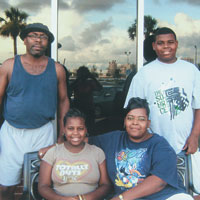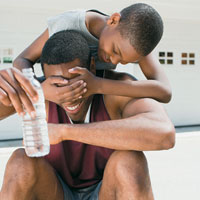You can change your family’s lifestyle from sedentary to active—the Orr-Browns did. After years of virtually no regular physical activities or exercise, Michelle Orr-Brown, 38; her husband Lawrence, 45; her 14-year-old daughter M’shawntis; and her 13-year-old son Marcus—who has severe hemophilia B—are now at their local YMCA four nights a week for up to two hours at a stretch.
“The kids love to play basketball, or we all go swimming. By the time we get home, all the kids want to do is shower and go straight to bed,” says Michelle. And that’s fewer hours of TV, computer and video gaming—significant risk factors for obesity.
The Orr-Browns are participants in Flexing for Fitness, run by the Nemours Children’s Clinic in Jacksonville, Florida. Funded by a National Hemophilia Foundation (NHF) grant, the program offers the families of children with bleeding disorders a free YMCA membership, along with nutritional counseling.
The family joined the program when they became increasingly concerned about Marcus’ weight. “He was always a big boy, but in the past couple of years he really started to get heavy,” says Michelle. A year later, he has lost 20 pounds; his sister has lost 30. Both parents have also experienced positive health effects. “It’s been such a wonderful change to all of our lives,” Michelle says.

Being overweight and having hemophilia are particularly risky, since the extra weight can cause stress to the joints and lead to bleeding within a joint. A 2004 study from the Centers for Disease Control and Prevention (CDC) demonstrated that being overweight was strongly associated with joint range-of-motion limitation, regardless of severity of disease. Rates of obesity among children with hemophilia are generally higher when compared with those in the general population.
Ed Kuebler, LCSW, social service coordinator for the Gulf States Hemophilia and Thrombophilia Center in Houston, recently studied the prevalence of obesity among people with hemophilia and found that among 353 subjects, 38% of youth and 59% of adults were overweight or obese, as determined by calculating body mass index (BMI). The BMI is calculated from a person’s weight and height. It is considered a good indicator of body “fatness.” According to the CDC, interpretation of the BMI for children is based on known age and sex ranges. This is different from adults, where the standard is the same for all men and women older than 20.
Many experts believe that an inactive lifestyle is the chief contributor to obesity in children with bleeding disorders. “This might be because of fear of causing bleeds, limited joint mobility and, to some extent, caution on the part of parents and gym teachers,” says physical therapist Kimberly Baumann, MPT, of the University of Minnesota-Fairview Center for Bleeding and Clotting Disorders in Minneapolis.
Michelle Orr-Brown was one of those vigilant parents. “I was a little too cautious,” she admits. “After so many years of hearing that Marcus ‘can’t do this’ and ‘can’t do that’—like playing football—you get comfortable in that zone of doing very little.” That becomes an easy habit for the entire family to pick up. “I would have felt guilty if the rest of us were going out and being active together without Marcus,” she explains.
But through their hemophilia treatment center (HTC), the Orr-Browns learned of activities and sports that can be safe for children with bleeding disorders. They also found out that being physically fit can reduce the risk of bleeds by making joints more stable. Another remarkable side effect of Marcus’ improved fitness, Michelle adds, is that his veins are larger and more accessible, making prophylaxis easier.
Breaking the Cycle
Kuebler agrees that overprotective parents sometimes discourage their children—overtly or subtly—from engaging freely in physical activity from an early age. In addition, he has observed that one of the biggest risk factors for childhood obesity is having overweight parents. “Obesity becomes an acceptable way of life in the family, even if it’s not well-received outside of the family,” he says.
The cycle continues as children gain weight and become less able to excel in sports and games alongside their peers. This causes low self-esteem, which can further isolate them at home, says Kuebler. “Kids can pick on each other pretty badly. They may be the last picked for the team, or even bullied because of their size. It’s a rare child who is obese and has a hard enough shell to move forward in life with confidence.”
 Unlike a bleeding disorder, obesity can be prevented and reversed. At the same time, the negative social and psychological effects can also be overcome. “It’s such a shame that kids suffer with this preventable condition on top of a bleeding disorder,” says Kuebler. “Every doctor’s office should be addressing this, as should every hemophilia clinic and treatment center. Families need help to get a handle on this problem early in their child’s life.”
Unlike a bleeding disorder, obesity can be prevented and reversed. At the same time, the negative social and psychological effects can also be overcome. “It’s such a shame that kids suffer with this preventable condition on top of a bleeding disorder,” says Kuebler. “Every doctor’s office should be addressing this, as should every hemophilia clinic and treatment center. Families need help to get a handle on this problem early in their child’s life.”
National health organizations have been sounding the alarm on childhood obesity. In 2003, the American Academy of Pediatrics described “widespread and profound societal changes” in childrearing that have affected children’s patterns of physical activity, as well as diet. These include more time spent in sedentary leisure activities; increased urbanization, so children spend less time walking or biking around their communities and to school; and declines in school physical education programming.
[Steps for Living: Physical Education, Sports Teams and Recess]
Take 30
For children with bleeding disorders, having a strong musculoskeletal system can prevent bleeds by enabling better joint stability, says Baumann. “You don’t need big, bulky muscles. You just need to keep them at a healthy length and strength through stretching, strengthening and regular aerobic activity.
“It is more important to be consistent. If you only exercise once a week, you are starting from square one each time in terms of the benefits,” Baumann adds. Doing something moderately aerobic for 30 minutes every day will give you better long-term results. It could be as simple as going for a walk after dinner, taking a bike ride or playing in the pool (not necessarily swimming laps). “You can even break up the 30 minutes by doing 15 in the morning and 15 in the evening,” she says.
The activity should be fun and family-oriented. “These routines work best when the family is involved,” Baumann says. While playing sports is great exercise, she recommends that children also pursue an additional daily activity, like walking the dog or shooting hoops, to instill a lifelong habit. “The nice thing about an everyday activity is that you are working the muscles in exactly the way you want to use them,” Baumann says.
If parents have any concerns about particular activities, Baumann recommends they read NHF’s “Playing it Safe” booklet, created by a physical therapist, which describes an array of sports, rates their safety and lists recommended precautions. In addition, HANDI, NHF’s information resource center, has resources for school personnel that address physical education for children with hemophilia.
Many clinics and HTCs offer their own weight loss and fitness programs, or can help families access others. One example is the National Heart, Lung, and Blood Institute’s We Can! (Ways to Enhance Children’s Activity and Nutrition). This program, now available in almost 800 communities nationwide, focuses on improving food choices, increasing physical activity and reducing “screen time”—the hours children spend in front of TVs, computers and video games. The free program includes all the components necessary to be adapted for organizations of all sizes. Teaching tools, worksheets and other materials geared toward parents, children, teachers and community leaders make the program simple to implement.
The other side of the weight-loss equation is diet. This is especially critical for children whose bleeding disorders sometimes limit their activity. “There are times when a child may have an active joint bleed and have to be immobilized for a while,” says Aida Miles, senior nutritionist at the Marcus Institute in Atlanta, which offers services for children with disabilities. “In this instance, all you have to work with is calorie intake.” This can be challenging, since inactivity and boredom can increase appetite. “When we have to stay put, we have more time to think about food and eating.” These thoughts can stimulate unnecessary snacking.
 Miles recommends talking to children about the difference between eating when hungry and eating for some other reason. “People eat for reasons unrelated to hunger—because it’s there, because it’s time to eat, because it looks good, because they are feeling sorry for themselves. If a parent always eats while watching TV, regardless of hunger, the child will, too.”
Miles recommends talking to children about the difference between eating when hungry and eating for some other reason. “People eat for reasons unrelated to hunger—because it’s there, because it’s time to eat, because it looks good, because they are feeling sorry for themselves. If a parent always eats while watching TV, regardless of hunger, the child will, too.”
Healthy eating, like healthy activity, should also be approached as a family enterprise. “What I am recommending for the child is really for everyone in the family,” says Miles. But instead of overhauling the family’s entire lifestyle at once, she suggests targeting one problem at a time. “I try to get the family to come up with one or two things they feel they can work on, rather than the 50 they could target. Once they achieve some level of success with those, they can move on to something else.”
Hemophilia of Indiana has referred families to the L.I.F.E. for Kids program operated by nearby St. Vincent Health in Indianapolis. Developed by a pediatric nurse, the program, Lifetime Individual Fitness and Eating, helps participants set step-by-step nutrition and exercise goals. The kids receive a list of simple exercises—crunches, squats and push-ups—and record how many they do each week, consistently trying to increase the number. They also keep a food journal. They meet weekly with a nurse who reviews the journal, tracks their progress and helps them remain accountable. Group events foster peer-to-peer support and family involvement.
Nutritional programs typically emphasize introducing new foods to the family table. This may take several attempts. Experts say you need to try a new food two, three or more times to know if you really like it. Michelle found that after a couple of tries, her children accepted healthier bottled green tea as a substitute for high-calorie juices. “They like it slushy, straight from the freezer, so that’s how they drink it.”
Understanding food labels and teaching children how to read them can pay off, too. Michelle now brings her children to the grocery store, where together they analyze carbs, calories and fat. This gives them more independence in selecting foods they want to eat and helps them develop the lifelong skills to make good choices.
One day, parents will need to turn over full responsibility for maintaining fitness and health to their children, just as they do for their bleeding disorders care. The best thing parents can do is provide the education and set the example. “I really hope my kids can sustain this after they leave home,” says Michelle. “I know they now understand what they need to do to be healthy.”


 Turn off the TV. Television programming aimed at children is notorious for continuous junk food ads touting sweet cereal, fast food, candy and soda. Studies show that what kids see advertised on TV is what they want to eat or buy. Reduce temptation by reducing TV time and talking to your children about the motivations and impact of the advertising industry.
Turn off the TV. Television programming aimed at children is notorious for continuous junk food ads touting sweet cereal, fast food, candy and soda. Studies show that what kids see advertised on TV is what they want to eat or buy. Reduce temptation by reducing TV time and talking to your children about the motivations and impact of the advertising industry. Treating children who are overweight or obese has several components. The American Academy of Family Physicians recommendations for parents include:
Treating children who are overweight or obese has several components. The American Academy of Family Physicians recommendations for parents include: